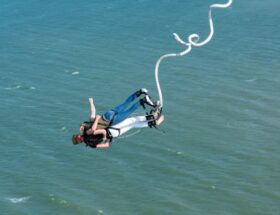If you’re anything like me, you’ve always been fascinated by the beauty of the night sky. One of nature’s most mesmerizing spectacles is the Aurora Borealis, or as they are often called, the Northern Lights. The colorful, shifting ribbons of light dancing across the night sky seem like something out of a dream, and they captivate anyone lucky enough to witness them. But what are they, really? And where and when can you go to experience this incredible phenomenon for yourself?
Let’s dive into the magic of the Aurora Borealis!
What Are the Aurora Borealis?
The Aurora Borealis is the result of interactions between charged particles from the sun and Earth’s magnetic field. After traveling millions of miles from the sun during solar storms, these particles collide with gases in our planet’s atmosphere—specifically oxygen and nitrogen. These collisions release energy, which creates the dazzling display of lights that we see.
The colors you see in an aurora depend on which gases are involved in the collisions. Green is the most common color and is produced when the charged particles interact with oxygen. Red, rarer and more vibrant, also comes from oxygen at higher altitudes. Meanwhile, blues and purples are caused by nitrogen.
In a way, the auroras are Earth’s own light show, painting the night sky with glowing swirls of green, pink, purple, and even deep red. The sheer size and movement of the lights, often stretching for miles and shifting like waves, make the experience utterly captivating.
When Is the Best Time to See the Northern Lights?
Timing is everything when it comes to catching the Aurora Borealis. The lights are most visible in winter and early spring (from September to April) when the nights are long and dark. Peak viewing times are typically between 10 p.m. and 2 a.m., though the lights can appear as early as dusk or persist until just before dawn.
Another factor to consider is the solar cycle. The sun goes through an 11-year solar cycle, where solar activity (and the frequency of auroras) fluctuates. We are currently in Solar Cycle 25, which is predicted to peak around 2025. This means that in the next few years, we could experience heightened aurora activity, making it the perfect time to plan your trip!
Clear skies are key! Cloud cover can spoil the view, so try to pick a time when the weather forecast is favorable for clear skies.

The Best Places to See the Aurora Borealis
To witness the Northern Lights, you need to be in a place with minimal light pollution and a clear view of the horizon. Since the auroras are typically visible near the magnetic poles, northern latitudes offer the best chances for sightings. Here are some of the best places to see this natural wonder:
1. Tromsø, Norway
Nestled in the Arctic Circle, Tromsø is one of the most popular destinations for aurora hunters. It’s easily accessible and offers a range of tours designed to chase the lights. The city is also a gateway to other winter adventures like dog sledding, snowshoeing, and Sami culture tours.
2. Abisko, Sweden
Abisko National Park, located in Swedish Lapland, is one of the top places for seeing the Northern Lights. It boasts the “Blue Hole,” a patch of sky that remains clear even when the surrounding areas are cloudy, providing more opportunities for a clear view. The region is also home to the famous Aurora Sky Station, where visitors can watch the lights from a mountaintop observatory.
3. Reykjavik, Iceland
Iceland is another hotspot for aurora viewing, and the best part is you don’t have to travel far from Reykjavik to catch a glimpse. Just a short drive outside of the city’s light pollution can provide some spectacular views. For a more immersive experience, head to the remote Westfjords or the Jokulsarlon Glacier Lagoon, where the lights reflect off the icy waters.
4. Fairbanks, Alaska, USA
Fairbanks sits directly under the “Auroral Oval,” a ring-shaped zone above the magnetic pole where auroras are most likely to occur. The town also offers viewing lodges and guided tours that take you into the Alaskan wilderness for the best sights. Late February to early March is the peak time here for bright auroras.
5. Yellowknife, Canada
Known as the “Aurora Capital of the World,” Yellowknife in Canada’s Northwest Territories is one of the most reliable places to see the Northern Lights. With over 240 nights of auroral activity per year, it offers some of the clearest skies and highest chances of seeing the phenomenon. Many lodges in the area are specifically designed for aurora viewing, with heated cabins and glass igloos.
6. Rovaniemi, Finland
For a more festive experience, head to Rovaniemi, the official home of Santa Claus! Located in Finnish Lapland, Rovaniemi offers the chance to combine a Northern Lights trip with visits to Santa’s village, reindeer safaris, and stays in cozy glass igloos, where you can watch the lights from the comfort of your bed.

Tips for Catching the Aurora Borealis
- Stay up late: The best times for viewing are usually between 10 p.m. and 2 a.m., so be prepared for some late nights.
- Dress warmly: Many aurora-viewing locations are in Arctic or sub-Arctic regions, so pack layers to stay warm while you wait for the show.
- Check the forecast: Sites like the Space Weather Prediction Center and the Aurora Forecast can help predict auroral activity, but it’s always a bit of a waiting game. Flexibility is key!
- Avoid light pollution: The farther you are from city lights, the better. National parks and remote wilderness areas are great for this.
- Patience is crucial: Auroras are unpredictable, so give yourself several nights to improve your chances of seeing them.
Conclusion: Chase the Magic!
The Aurora Borealis is one of the most spectacular natural displays on Earth, a true bucket-list experience for anyone enchanted by the wonders of the sky. Whether you’re trekking through the snowy landscapes of Norway, relaxing in a glass igloo in Finland, or gazing at the sky from a remote Canadian cabin, the Northern Lights are sure to leave you in awe.
So why not plan your next adventure around chasing this magical light show? As we move toward the peak of the solar cycle, your chances of witnessing the Northern Lights are better than ever.
Until then, keep looking up!
GertieBlu is where we explore the wonders of the world—from the skies to the seas and everything in between. Whether you’re a seasoned traveler or a dreamer planning your next adventure, stay tuned for more stories that inspire you to see the world in a new light!









